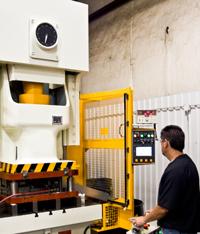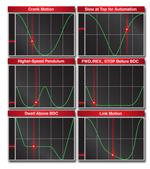- FMA
- The Fabricator
- FABTECH
- Canadian Metalworking
Categories
- Additive Manufacturing
- Aluminum Welding
- Arc Welding
- Assembly and Joining
- Automation and Robotics
- Bending and Forming
- Consumables
- Cutting and Weld Prep
- Electric Vehicles
- En Español
- Finishing
- Hydroforming
- Laser Cutting
- Laser Welding
- Machining
- Manufacturing Software
- Materials Handling
- Metals/Materials
- Oxyfuel Cutting
- Plasma Cutting
- Power Tools
- Punching and Other Holemaking
- Roll Forming
- Safety
- Sawing
- Shearing
- Shop Management
- Testing and Measuring
- Tube and Pipe Fabrication
- Tube and Pipe Production
- Waterjet Cutting
Industry Directory
Webcasts
Podcasts
FAB 40
Advertise
Subscribe
Account Login
Search
Servo helps stamper expand capabilities, hold down costs
Many functions, one press
- By Becky McCarty
- November 25, 2008
- Article
- Bending and Forming

Servoforming technology allowed Master Mfg. to produce a high-carbon-steel tapped appliance component, executing the tapping in-die to eliminate secondary operations. ServoPro's capability to control slide position and stroke velocity allows one press to do the job of several presses, improving productivity.
Evansville, Ind.-based Master Mfg. Co. has built a thriving business as a supplier of high-quality, small metal stampings and clips to the appliance, automotive, electrical, lighting, and other industry segments using primarily four-slide presses.
The 38-year-old company is a fully integrated manufacturing operation with in-house design and engineering capabilities and a state-of-the-art toolroom for building and maintaining dies. Its 86,000 square feet of manufacturing space also holds two austemper heat-treating lines along with zinc electroplating, phosphating, and dip-spin painting.
Master Mfg. stamps numerous parts in the 10 million estimated annual usage (EAU) range and has the capability to produce more than 500 million parts annually. Yet the manufacturer's lead-time is short—about three to four weeks from design to production.
"Housing all these processes, including waste treatment, under one roof gives us total control over tooling, production, quality, and delivery and allows us to be competitive on a global scale," said John Gannon, executive vice president for Master Mfg.
Expanded Capabilities
The manufacturer decided to increase its capabilities with a press purchase to take on new customer requirements for processes like in-die tapping. Without in-die tapping, parts have to be moved to a tapping station, adding handling and labor cost to the part.
"We also wanted to double our tonnage capacity yet have the ability to retain a 4-inch stroke length to accommodate our existing dies," Gannon said. The manufacturer had been using its tooling on an 80-ton press with a 4-inch stroke.
"But we really weren't interested in investing the capital or dedicating the floor space to four or five different presses. Instead, we wanted to find one press that could perform multiple functions," he said.
Servo's Stroke Velocity Control Ideal for In-die Tapping HSS Part
The company's needs led it to investigate the different servo-driven press models on the market. "We discovered that AIDA's ServoPro® servoforming technology would allow us to select short stroke options without sacrificing speed," Gannon said.
Master Mfg. installed an AIDA 150-metric-ton NC1 gap-frame press equipped with ServoPro to perform in-die tapping on a part for the appliance industry using 0.070-in.-thick high-carbon steel.
With the servo-driven gap-frame press, the company also gained control over stroke velocity for in-die tap work. The manufacturer designed and built a die for its high-carbon-steel appliance component that required in-die tapping. "Servoforming technology allowed us to run a tool and produce a part we could not have made with our current press lineup," said Gannon.

Figure 1Click image to view larger The servo drive gave Master Mfg. the flexibility to optimize press operations by providing a programmable stroke that offers an infinite number of combinations.
With in-die tapping, Master Mfg. found it was able to eliminate secondary operations and maintain control over the entire production process (see lead image). In conventional operations, the part would have to be moved to a tapping station, adding cost to the part with additional handling and operators. "We were able to give our customer a nearly 40 percent price reduction," Gannon said.
Controlling stroke velocity improved Master Mfg.'s ability to form the high-carbon spring steel. Formability decreases as carbon levels increase. Instead of applying high tonnage to difficult-to-form materials, ServoPro's ability to modify the stroke profile means pressure can be held at the bottom of the stroke, then released and reapplied as needed to produce a more accurate and complete part (see Figure 1).
Long Tap Life. The company also wanted to maximize tap life without sacrificing speed.
Typically, fast speeds tend to shorten the life of the tap. Taps have a maximum tapping velocity. Attempts to form material at speeds faster than that reduce tap life because of the wear and tear on the tap. In a conventional press, the speed required to produce the part dictates the speed at which the press must operate through the entire work cycle.
The servo-driven press's capability to program different stroke velocities within a single stroke or work cycle allows it to run at higher strokes per minute (SPM) during the portion of the work stroke when the tap is not in contact with the material and then slow the cycle while the in-die tap is being performed. This capability extends the life of the tap and produces a more accurate part.
"To achieve maximum tap life, we knew we couldn't run the process faster than 35 SPM," Gannon explained. "Specifications for the process projected 5,000 to 15,000 parts per tap. We budgeted 10,000 parts per tap. The servo-driven press allowed us to slow the velocity of the stroke to achieve a good tap, then increase velocity in the nonworking part of the stroke for faster cycle rates. As a result, we've been able to achieve nearly 25,000 parts per tap, significantly increasing tap life with no reduction in thread quality."
Additional Benefits
The press also is being used to make an aluminum bracket for the recreational vehicle industry. The part design dictated design of a two-out die, nested to save scrap. "We needed the entire bed length for the two-out die but were able to use a 3-inch stroke for speed," Gannon said.
Built-in Die Protection. Master Mfg. runs two shifts five days a week. Die protection is an important function to increase uptime for the manufacturer, which designs and builds all its tooling. Whether a customer has part specifications or nothing more than a concept, the TS-16949- and ISO 14001-certified manufacturer is able to design and build the appropriate tooling. "The built-in die protection of the servo-driven press makes it easy for our operators to program, and installation of die sensors is a simpler procedure," Gannon said.
Using the hand crank feature of the servo-driven gap press optimizes die protection by allowing the operator to manually progress through the slide motion to ensure that die setup and synchronization of ancillary equipment are accurate before a production run. The handcrank motion reduces the potential for production of bad parts and also lends itself to the performance of test runs to verify new tooling designs.
"Our die maintenance has decreased," said Gannon. "As a result of the longer die life we're experiencing, production has increased at least 30 percent over our other presses. We also have less downtime due to misfeeds and buckling."
Energy Savings. While production numbers have risen, operating costs have dropped. The gap-frame press's servo technology uses capacitors to store energy when the servomotor is not under load (the nonworking portion of the stroke). When the motor is loaded, power is drawn from the capacitors and not the facility's main line. As a result, power consumption is often lower than that of a standard mechanical press. Simply put, electrical energy is substituted for mechanical energy.
"Traditionally, four-slide machines are cheaper to run," said Gannon. "But the lower energy costs of the servo-driven gap press have made it possible for us to quote jobs similar to what we would run on our four-slides."
No Limits to Capabilities
Like a lot of stampers in the U.S., Master Mfg. is faced with rising costs for materials and energy yet is meeting the challenge to produce higher-quality parts with tighter tolerances by investing in more efficient equipment.
"With this servo-driven gap press, we can quote most any job that comes through the door," said Gannon. "After working with ServoPro and finding we can program up to 20 different velocities for a single stroke, we've learned there's no operation, die, or new job that we can't run. Flexibility is one of the ways we're able to remain competitive and capture jobs from going overseas.
About the Author
Related Companies
subscribe now

The Fabricator is North America's leading magazine for the metal forming and fabricating industry. The magazine delivers the news, technical articles, and case histories that enable fabricators to do their jobs more efficiently. The Fabricator has served the industry since 1970.
start your free subscription- Stay connected from anywhere

Easily access valuable industry resources now with full access to the digital edition of The Fabricator.

Easily access valuable industry resources now with full access to the digital edition of The Welder.

Easily access valuable industry resources now with full access to the digital edition of The Tube and Pipe Journal.
- Podcasting
- Podcast:
- The Fabricator Podcast
- Published:
- 04/16/2024
- Running Time:
- 63:29
In this episode of The Fabricator Podcast, Caleb Chamberlain, co-founder and CEO of OSH Cut, discusses his company’s...
- Trending Articles
AI, machine learning, and the future of metal fabrication

Employee ownership: The best way to ensure engagement

Steel industry reacts to Nucor’s new weekly published HRC price

How to set a press brake backgauge manually

Capturing, recording equipment inspection data for FMEA

- Industry Events
16th Annual Safety Conference
- April 30 - May 1, 2024
- Elgin,
Pipe and Tube Conference
- May 21 - 22, 2024
- Omaha, NE
World-Class Roll Forming Workshop
- June 5 - 6, 2024
- Louisville, KY
Advanced Laser Application Workshop
- June 25 - 27, 2024
- Novi, MI


























